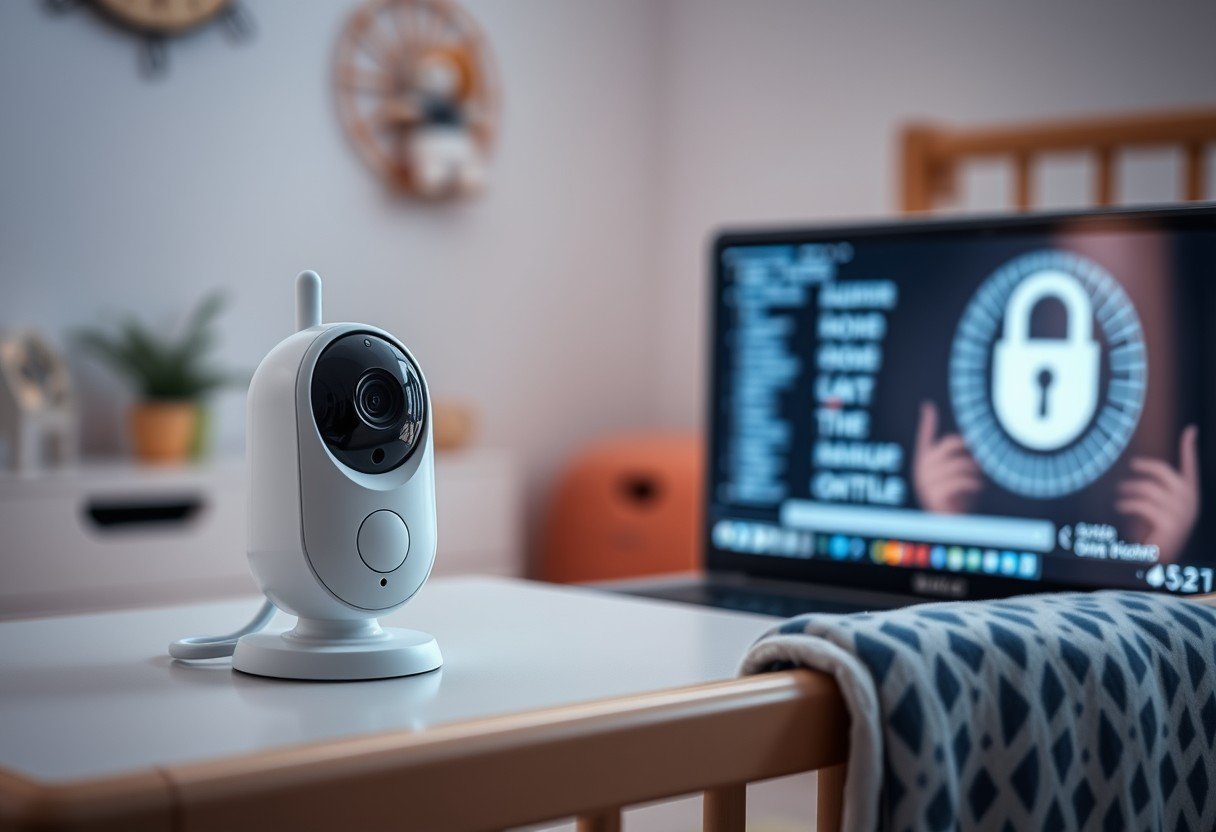Just when you thought your baby monitor was a safe haven, shocking reports revealed how hackers could access HelloBaby monitors. These incidents exploited common security gaps, turning a tool for peace of mind into a source of anxiety for parents. Understanding how these breaches happened is the first step to preventing them. This guide will walk you through the vulnerabilities and provide simple, effective steps to secure your device and protect your family’s privacy.
Why Are Baby Monitors Such a Common Target?
Baby monitors, especially those connected to the internet, offer a direct window into the most private spaces of a home. For hackers, this is a tempting target. They aren’t just looking to spy; they might want to cause emotional distress, steal personal information by accessing your network, or use your device to launch other cyberattacks.
The growing popularity of smart home technology means more devices are connected to the internet than ever before. A 2021 report found that attacks on Internet of Things (IoT) devices, like baby monitors, more than doubled in just six months. Many of these devices are shipped with weak security settings, making them easy targets for cybercriminals.
Hackers know that many users don’t change the default settings on their devices. This oversight provides an open door for them to gain access with minimal effort. They can use automated programs to scan for vulnerable devices online and then use default credentials to log in.
Key Security Flaws That Were Exploited
The HelloBaby monitor hacks were not the result of highly complex cyberattacks. Instead, they took advantage of some basic and unfortunately common security oversights. Understanding these weaknesses is crucial for every parent using a connected monitor.
Hackers primarily focused on a few key areas that gave them easy access. These weren’t sophisticated backdoors but simple security gaps that could have been closed with basic user awareness and better manufacturer practices from the start.
The biggest vulnerabilities came from poor password security and unencrypted data streams. When data isn’t encrypted, anyone who intercepts the signal between your monitor and your router can potentially view the feed.
- Default Usernames and Passwords: Many users failed to change the factory-set login credentials, which are often publicly available online.
- Lack of Strong Encryption: The video and audio data sent over the Wi-Fi network were not properly encrypted, making it simple for hackers on the same network to intercept the feed.
- Outdated Firmware: Devices running on old software often contain known security holes that manufacturers have since patched. Hackers specifically search for devices that haven’t been updated.
These issues combined created a perfect storm, allowing unauthorized individuals to watch and even communicate through the monitors, causing immense distress to families.
Simple Steps to Secure Your Baby Monitor Today
You don’t need to be a tech expert to dramatically improve the security of your baby monitor. By taking a few proactive steps, you can lock down your device and ensure your family’s privacy remains intact. These measures are simple, quick, and incredibly effective.
Start with the most basic but most important step: your password. From there, securing your network and keeping your device’s software current will create multiple layers of protection.
Here is a simple checklist to follow:
- Change the Default Password Immediately: Before you do anything else, change the default username and password. Create a strong, unique password that is at least 12 characters long and includes a mix of upper and lowercase letters, numbers, and symbols.
- Secure Your Home Wi-Fi Network: Your monitor is only as secure as the network it’s connected to. Ensure your Wi-Fi is protected with WPA3 or WPA2 encryption. If you still have an open network, secure it with a strong password right away.
- Keep the Firmware Updated: Manufacturers release firmware updates to patch security vulnerabilities. Check for updates regularly in the device’s app or manufacturer’s website and install them as soon as they are available.
- Disable Features You Don’t Use: If your monitor has a remote access feature that allows you to view the feed from outside your home network, turn it off unless you absolutely need it. This reduces the number of ways a hacker can try to gain access.
Who is Responsible for Baby Monitor Security?
When a security breach happens, it’s natural to ask who is at fault. The truth is that security is a shared responsibility between the manufacturer that builds the device and the user who operates it in their home. Both play a critical role in keeping the device safe from intruders.
Manufacturers have a duty to design products with security in mind from the ground up. This includes using strong encryption, requiring password changes during setup, and providing timely security updates. However, even the most secure device can be vulnerable if the user doesn’t follow basic security practices.
This table breaks down the key responsibilities for both sides:
| Manufacturer Responsibilities | User Responsibilities |
| Design products with strong, built-in security features. | Change default login credentials to a strong, unique password. |
| Provide regular and easy-to-install firmware updates. | Ensure the home Wi-Fi network is secure and password-protected. |
| Be transparent with consumers about known vulnerabilities. | Regularly check for and install firmware updates. |
| Offer clear guidance on how to use the device securely. | Disable features like remote access when not needed. |
By working together, manufacturers and users can create a much safer environment and significantly reduce the risk of hacking incidents.
What to Do if You Suspect Your Monitor is Hacked
Discovering that your baby monitor may have been compromised is a terrifying thought. If you notice strange activity, such as the camera moving on its own, unfamiliar voices coming through the speaker, or settings changing without your input, it’s crucial to act immediately to protect your family.
Don’t panic. Taking swift and decisive action can lock out the intruder and help you regain control over your device and your home network.
First, immediately disconnect the baby monitor from your Wi-Fi network by unplugging it from the power source. This will sever the hacker’s connection. Once it’s offline, you can take further steps to secure your home. Change the password for your home Wi-Fi network to kick out anyone who may have gained access.
After securing your network, perform a factory reset on the baby monitor. This will erase its settings and any changes the hacker might have made. When you set it up again, be sure to create a new, very strong password for the device itself before reconnecting it to your newly secured Wi-Fi network.
The Future of Baby Monitor Security
The incidents involving HelloBaby monitors served as a major wake-up call for both consumers and manufacturers. As a result, the future of baby monitor security is heading towards more robust and intelligent solutions designed to stay one step ahead of potential threats.
We can expect to see more advanced security features become standard. Technologies like artificial intelligence (AI) and machine learning will play a larger role in detecting and preventing unauthorized access in real-time. For instance, a monitor could learn your typical usage patterns and alert you to any unusual activity, such as a login from an unrecognized location.
Ultimately, the most powerful tool for security is knowledge. As consumers become more educated about the risks of connected devices, they will demand higher security standards from manufacturers. This shift in consumer priority will drive the industry to build safer, more trustworthy products, ensuring that tools designed to protect children don’t become a threat to their safety.
Frequently Asked Questions about Baby Monitor Security
How do I know if my baby monitor has been hacked?
Look for signs like the camera moving on its own, strange voices or noises coming from the speaker, or the security settings being changed without your knowledge. An LED light turning on when you are not viewing the feed can also be a warning sign.
Are non-Wi-Fi baby monitors safer than Wi-Fi models?
Monitors that use closed-loop systems (like FHSS) are generally considered more secure from remote hacking because they don’t connect to the internet. However, they have a limited range and someone nearby could potentially intercept the signal if it’s not encrypted.
How often should I update my baby monitor’s firmware?
You should check for firmware updates at least once every few months or whenever you hear about a new security threat. Many modern devices will notify you through their app when an update is available, so be sure to install it promptly.
What makes a password “strong”?
A strong password is long (at least 12-15 characters), complex (using a mix of uppercase and lowercase letters, numbers, and symbols), and unique (not reused for any other account). Avoid using personal information like birthdays or names.
Can hackers access my other devices if my baby monitor is hacked?
Yes, this is a serious risk. If a hacker gains access to your baby monitor, they may be able to use it as a gateway to access other devices connected to your home Wi-Fi network, such as computers, phones, or other smart home gadgets.






Leave a Comment